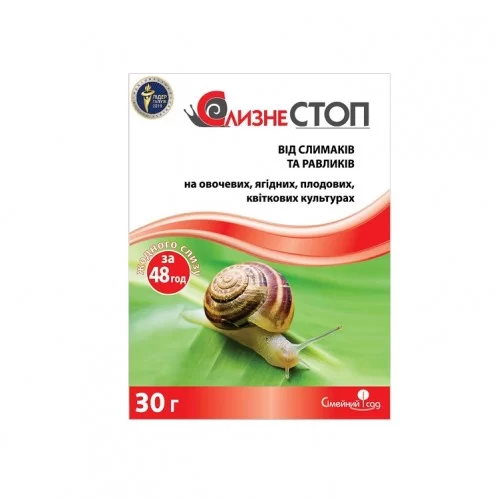- Active ingredient: metaldehyde 80 g/kg
- Preparation form: granular bait
- Period of protective action: 3 weeks
- Packaging: 30 g
- WHO classification: 3rd grade
Gardeners and market gardeners are often frustrated by slugs: in the morning, the best, ripest strawberries have wide, eaten holes. White streaks of dried mucus on the leaves also indicate that slugs have feasted there.
The main purpose of slug mucus is to constantly moisten the skin surface to retain moisture and reduce the snail's body temperature in hot weather. Although slugs have primitive lungs, two-thirds of their breathing is done through moist skin. Therefore, drying out of the mucus leads to the death of slugs from suffocation, overheating and dehydration. That is why SlizneSTOP is an effective drug for controlling these pests, the mechanism of action of which is aimed at "drying" slugs after contact with the drug.
When in contact with the body of a snail or when ingested, metaldehyde causes paralysis of the snail and stimulates the work of numerous mucous glands. The snail literally "drains" mucus and "drys up". In addition, the granules of the drug have pronounced attractant (attractive, attractive) properties, snails feel an attraction to the drug at a distance of up to 0.5 m, actively search for the granules and eat them.
| Culture | Spectrum |
| Vegetable, fruit, ornamental and flower crops, grapes and berries | All types of snails and slugs (bordered snail, reticulated snail, red Spanish and red Arion snail, striped garden snail, pale road snail, field or pachytean snail, large snail, grape snail) |
The reticulated snail causes great damage to tomatoes, cabbage, cucumbers and strawberries. Garden snails damage the tender stems of flower and vegetable crops, but they especially like lettuce, cabbage, sweet peppers, and can even gnaw on pumpkins. The snail is a major pest in vegetable storages, greenhouses and cellars. The field snail and the red arion devour swollen (ready to germinate) seeds and seedlings of vegetables and legumes (soybeans, lentils), cereal crops (winter wheat, rye, barley), and the red Spanish snail, due to its gluttony, eats everything edible that comes its way.
Consumption rates: 30 g per 10 m2
Method of application: Scattering granules on the soil surface in places of accumulation, between rows, on paths




